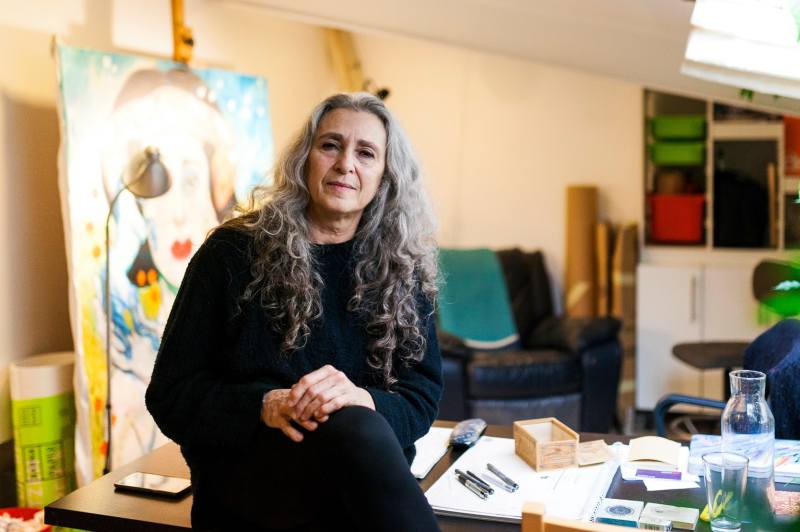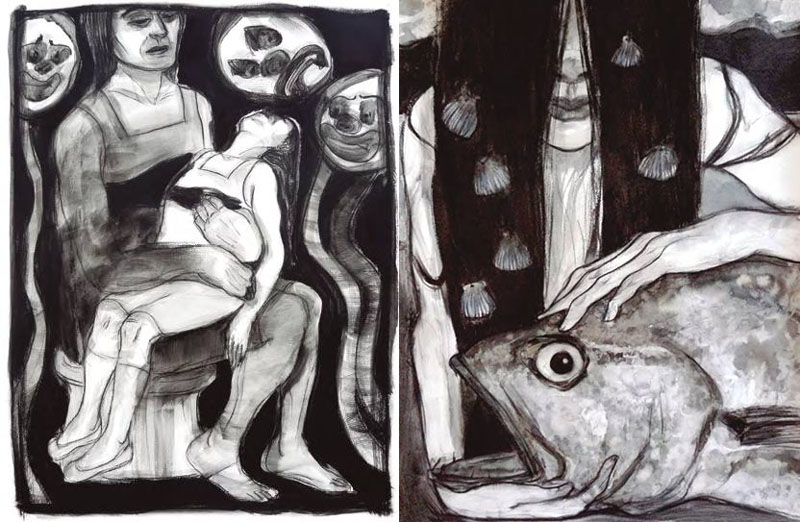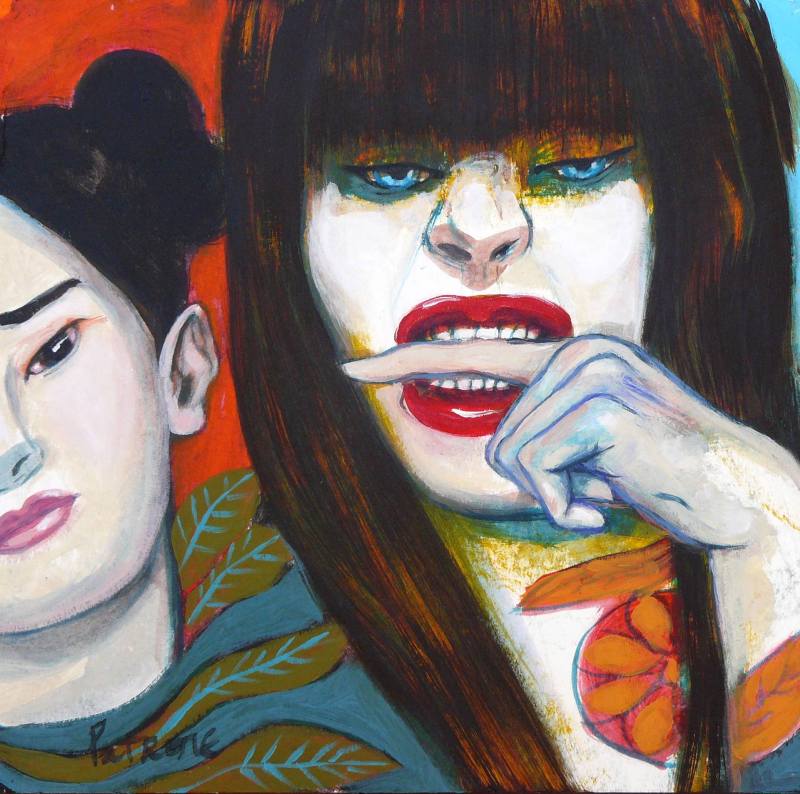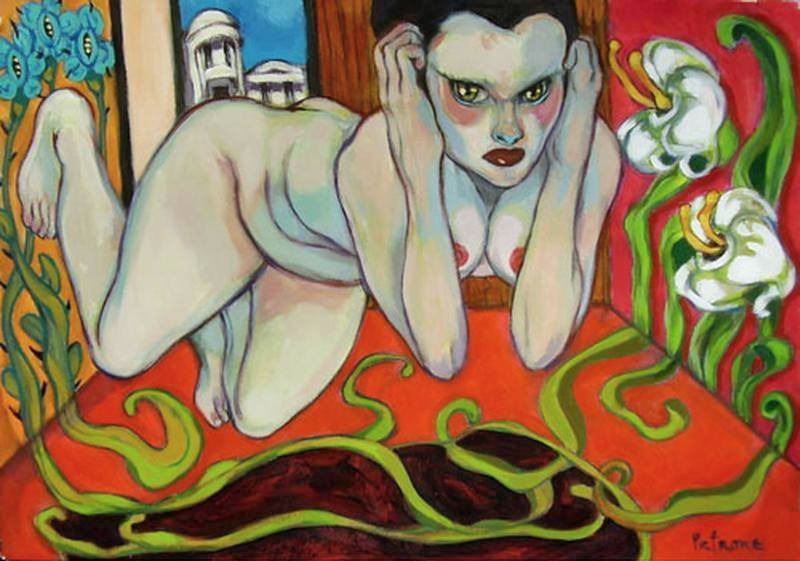Empezamos el año como terminamos el anterior, con una entrevista de Shirley Rebuffo. La escogida en esta oportunidad es la uruguaya Virginia Patrone, creadora de una extensa obra fruto de una intensa actividad artística desarrollada a lo largo de varias décadas entre Montevideo, Barcelona y Madrid.
El artículo va en dos partes, el primer post con texto en español y este segundo en inglés.
We begin the year as we ended the previous one, with an interview by Shirley Rebuffo. The chosen one this time is the Uruguayan Virginia Patrone, creator of an extensive body of work, the result of an intense artistic activity developed over several decades between Montevideo, Barcelona and Madrid.
The article has in two parts, the first post with text in Spanish and this second one in English.
________________________________________________________
Virginia Patrone
(Montevideo, Uruguay, 1950-)
Virginia Patrone. Foto / Photo: Valentina Barreto
Virginia Patrone is an artist of Italian and French descent, born in Montevideo, Uruguay, on March 31, 1950. In 2003 she settled in Barcelona, between 2005 and 2009 she lived between Madrid and Barcelona, and since 2010 she has had a studio in Barcelona and Montevideo. She has been working as an artist since 1979.
Virginia works at the crossroads of expressive forms: theater, poetry, photography, video, which materialize in drawings and paintings. Deeply and totally interested in contemporary thought, Giorgio Agamben, Pascal Quignard, Jean-Luc Nancy or Georges Didi-Huberman are her source of inspiration and feed her creativity.
She spent her childhood at a high point of Montevideo's culture: she lived her youth under military dictatorship in permanent fear and resistance. A young mother of four children, she was a night painter.
She hid her work and her thoughts until the return of democracy. With a long and deep trajectory in the plastic arts, she left Montevideo to settle in Barcelona.
She has higher studies in architecture, painting studies in a Montevidean workshop with Torres-Garcia's methodology, engraving studies with a New York master, and obtained a Fullbright Scholarship thanks to which she studied in New York in 1988.
She has developed an intense collaboration with artists of her generation in workshops and joint projects, participating in international solo and group exhibitions since 1983 in various countries, galleries and museums: from the Metropolitan Museum in Tokyo, to the National Museum of Visual Arts in Montevideo.
"Retrato de una poeta herida / Portrait of a Wounded Poet"
Óleo sobre tela / oil on canvas, 73 x 73 cm., 2010
"El descubrimiento / The Discovery", acrílico sobre tela / acrylic on canvas, 180 x 150 cm., 2005
Interview by Shirley Rebuffo
Shirley Rebuffo: How did your inclination for painting begin? Tell us about yourself, how you started painting, your connection with art.
Virginia Patrone: Painting came with me, at least it is one of the first experiences of consciousness of being that I have. The environment was propitious: I am an only child and I lived my first ten years in a third floor apartment on Buenos Aires Street, in Ciudad Vieja, Montevideo's historic center, my thoughts and I with papers and watercolors, music, a big book by Leonardo Da Vinci, and periodic film projections on the wall of the living room.
La danzarina ausente / The Absent Dancer", acrílico sobre tela / acrylic on canvas, 148 x 107 cm., 2011
Colección / Collection Carolina Oehler
Izq./ Left: "Yo habría sido muy enamoradiza, yo me conozco /
I would have been too much in love, I know myself"
Carboncillo sobre papel Hahnemühle / charcoal on Hahnemühle paper, 65 x 50 cm., 2015
Der./ Right: "Su boca que reía yo no pude matar / His laughing mouth I could not kill"
Carré negro con aguada de cola vinílica sobre papel Hahnemühle Bamboo 265 g /
black carré with vinyl glue gouache on Hahnemühle Bamboo paper 265 g, 40 x 30 cm., 2018
SR: Who were your references?
VP: Leonardo first, of course. Then the universe expanded a lot and I'm sure that cinema, so big and indoors, had a great influence. Fellini, for example. And going out in the street, going to museums, Uruguayan painting, Barradas, Torres-García, the Planists. Uruguayan and Argentinean comic artists, the discovery of ukiyo-e. Women: Leonora Carrington, Remedios Varo, Nancy Spero.
"Búho / Owl", acrílico sobre tela / acrylic on canvas, 157 x 99 cm., 2012
"Mujer dragón entre dos mundos / Dragon Woman Between Two Worlds"
Acrílico sobre tela / acrylic on canvas, 97 x 130 cm., 2010
SR: How did you find your language?
VP: By doing, by flowing, not looking for a place to arrive but paying attention to what is ahead and what is inside. Going back and forth across the boundary of reality, looking on the other side for what to bring and working to make it visible.
"Vendrá un tiempo de crímenes felices / There will come a time of happy crimes"
De las serie "La Señora Macbeth" / From Lady Macbeth Series
Acrílico sobre tela / acrylic on canvas, 148 x 108 cm., 2013
Colección / Collection Engelman-Ost
"La mujer tatuada / The Tattooed Woman", acrílico sobre tela / acrylic on canvas, 135 x 185 cm., 2010
SR: Living between two hemispheres, what is your work rhythm like?
VP: Mysterious, continuous, permanent. Sometimes it's only interior, only in thought; it comes out on paper, on canvas, or in words, when the time is right.
SR: How do you put an end to a project that takes so much effort and time?
VP: When the project itself tells me so, when I can't add anything more, when it closes and leaves me out.
SR: What does it mean to you to enjoy what you do?
VP: To live.
"Un día, sin hablar / One Day, Without Speaking"
Acuarela y tintas sobre papel / watercolor and inks on paper, 29,7 x 21 cm., 2018
"Tigre, tigre / Tiger, Tiger"
SR: You have gone through different experiences regarding your way of working, that's why this question: Do you prefer to work alone in any of your workshops, or with other colleagues in collective processes?
VP: I prefer to work alone most of the time, but collaboration, when it happens naturally, is wonderful.
Izq./ Left: "Se le hizo saber desde el principio que no saldrá nunca de aquí /
It was made known to her from the beginning that she will never leave here"
Carboncillo sobre papel Hahnemühle / charcoal on Hahnemühle paper, 65 x 50 cm., 2015
Der./ Right: "Chanquete / Transparent Goby"
Carboncillo y acuarela sobre papel / charcoal and watercolor on paper, 67 x 50 cm., 2008
Colección / Collection Engelman-Ost
"Tango y Pan con abisales / Tango and Pan With Abyssal"
Acrílico sobre tela / acrylic on canvas, 130 x 100 cm., 2018
SR: Is it important for you as an artist to generate your own pictorial, textual and reflective analysis of social events? This question points to your series where your paintings are a means of communication that evolves through events, sometimes very harsh, and carry a message. So we have Iris, Lady Macbeth and others. What are the challenges involved in doing that kind of work?
VP: For me, analysis and reflection from the place and through art is fundamental. It is a form of knowledge that includes the intuitive, the archetypal, the myths, the collective unconscious. This way of working the themes allows to communicate and multiply the reflection, to make possible other ways to understand. I work with emotion. Traversing these themes requires me to cross psychological and emotional boundaries, to relate to the surviving images they carry, without getting lost. The task includes using safety distances, hence the introduction of the comic format, for example.
"Pintalabios y muñeca / Rouge & Doll", acrílico sobre papel / acrylic on paper, 30 x 30 cm., 2010
"El sueño difícil / The Difficult Dream", acrílico / acrylic, 70 x 100 cm., 2005
SR: What criteria did you follow to select the women who appear in these series where you read reality?
VP: I simply took the ones that presented themselves to me, the ones that came.
SR: What has been your impossible battle?
VP: Always the hardest thing to achieve is to understand, really, deeply. Iris dedicated her life to understanding and her wake is still trying to make us understand, Lady Macbeth too. The why of the passage to the act, why to put in reality that which generates destruction, repentance. What is free will, what is the limit, what is normal, what is madness. The place of women in societies as distant as Shakespeare's or Montevideo's in the thirties and today's, particularly marks these stories, be they reality or fiction.
"Kitsune", acrílico sobre tela / acrylic on canvas, 97 x 130 cm., 2010
"El jardín de la milonga / The Milonga Garden", acrílico / acrylic, 155 x 200 cm., 2003
SR: You channel your feelings intensely in your works. Do you find it cathartic to create?
VP: It is possible. Undoubtedly it is a form of healing, although the part that we could call professional, the method, the work, is very strong. In cases like the above I have to relate to emotions and feelings that are not part of my experience, I have to act, relate to these ghosts.
SR: Regarding the relationship between love and painting: has love or lack of love influenced your painting?
VP: Inevitably.
"Árboles genealógicos / Family Trees", acrílico sobre tela / acrylic on canvas, 97 x 130 cm., 2010
"El halcón de Freud / Freud's Falcon"
Acrílico sobre papel / acrylic on paper, 30 x 30 cm., 2011
SR: What do you like most or what stimulates you most about your work as a teacher?
VP: The relationship with others, perceiving what they want to achieve and helping them to achieve it.
"Tarea del crepúsculo: coronarse de tinieblas / Twilight Task: Crowning of Darkness"
Acuarela y tintas sobre papel / watercolor and inks on paper, 28 x 21 cm., 2018
"Manía II / Mania II", acrílico sobre papel / acrylic on paper, 50 x 70 cm., 2004
SR: Could you tell us about any artistic and cultural project you have planned for the future?
VP: I have an immediate project in the works: "Los Fantasmas de Venus" (The Ghosts of Venus). It is a book of poetry and watercolors, things I have been writing or painting in the last few years. Right now I am working on a project of which I will not say anything, for now. The future project that awaits its moment is Xirgu, combining plastic and theater, Montevideo and Barcelona, women from two cities, two languages.
"Muñequitas de arrabal / Suburbian Little Dolls", acrílico / acrylic, 100 x 100 cm., 2003
SR: Do you have any anecdotes you would like to share with us?
VP: Having just a few days to present a project that is very important to me, there is an urgent alarm that blocks all colloquial grace. I ask my memory and it doesn't want to give me anything. I remain in debt on this part.
"Qué has hecho de mi pobre corazón / What Have You Done to my Poor Heart"
Acrílico sobre tela / acrylic on canvas, 100 x 130 cm., 2018
________________________________________________________
About mentioned artists:
Rafael Barradas: [Uruguayos (III)], [Recolección (CXLVI-1)]
Joaquín Torres-García:
[Uruguayos (XII)], [Aniversarios (XXVII)], [Arte perdido (X)], [Hermenegildo Sábat (Caricatura, Pintura)], [Recolección (CXLVI-1)], [Ventanas (III)]
Leonora Carrington:
[Héctor Pineda (Arte Digital)], [Recolección (LIII)], [Recolección (XCVI)], [Aniversarios Fotografía (CCXXXII)], [Recolección (CXLI-2)]
Nancy Spero: Wikipedia
________________________________________________________
Más sobre / More about Virginia Patrone:
¡Muchas gracias por la entrevista, Virginia!
Thanks a lot for the interview, Virginia!
________________________________________________________
Shirley Rebuffo has a Degree in Library Science and a Degree in Archivology by the Universitary School of Library and Related Sciences (Montevideo, Uruguay), Technician in Museology by the Faculty of Humanities and Sciences (Anthropology option), Object, Symbol and Spance in Curatorship Applied Museology and Social Museology - Concepts, Technics and Practice (Campo Grande, Brazil), Coaching (Campo Grande, Brazil), Strategic Planning (Campo Grande, Brazil), and Art and Painting student under Master Eduardo Espino.























What a great artist;)
ResponderEliminar